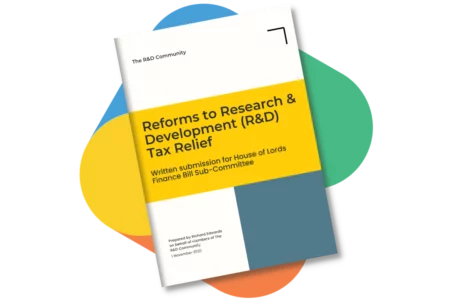What a report it was! Based on evidence from advisory firms, tax professionals, academics, membership organisations and PCRT bodies, its 78 pages painted a vivid portrait of the many issues currently affecting the R&D tax relief scheme. It also made some pointed suggestions on what the Government should do to resolve them!
If you have time, we’d encourage you to read the report in full. If not, we’ve summarised some of the issues and recommendations here.
Issues identified
In the report, the Subcommittee described a lot of issues with the current R&D tax relief scheme and raised a few concerns about the draft legislation.
Lack of ambition
The Government’s economic aim is that 2.4% of GDP is spent on R&D. In contrast, other countries in the Organisation for Economic Cooperation and Development (OECD) have an average rate of 2.7%. The report raised concerns that 2.4% is not ambitious enough – especially as some countries spend close to 5% on R&D.
Reporting on error and fraud
In its accounts for 2021-2022, HMRC had estimated that 4.5% (£469m) of the total cost of the R&D schemes was associated with error and fraud. However, the report points out that these are very separate issues, and HMRC can’t give statistics on either individually.
Ineffective and poorly targeted compliance efforts
The report highlighted general concerns about HMRC’s attempts to police the scheme. First, witnesses felt these efforts were largely inadequate, with many ineligible claims still processed. Secondly, they felt that checks were poorly targeted, meaning many genuine claimants have been caught in the net. The report also noted that HMRC may not be meeting the standards of its own Charter, which requires officers dealing with the taxpayer to have the right level of expertise.
A lack of consistency in enquiries
Many witnesses complained that HMRC wasn’t consistent in its approach to enquiries, with opinions about eligibility differing between caseworkers or inspectors. They also reported a high turnover of staff and a bias towards letters over discussion. This left many advisors feeling frustrated that the outcome of an enquiry could be so variable, and the process so inflexible.
A lack of resources
Questions were also raised about HMRC’s resources. The report pointed out that HMRC are already having trouble policing the scheme in its current form, and April’s rule changes will make things even more complicated. This is a nuanced and specialist area, but witnesses felt that HMRC’s approach to compliance checks was overly simplistic and draconian. They suggested it could be due to the lack of trained, experienced staff at HMRC who can differentiate the genuine claims from the problematic.
Pre-notification of R&D claims
The draft legislation includes a requirement for first-time claimants to notify HMRC in advance of making an R&D claim. However, the Subcommittee felt that this was “uniquely onerous” and of questionable benefit in preventing abuse. The report recommended that the Government remove this requirement from the draft Finance Bill.
Long-awaited guidance and limited time to prepare
The Subcommittee pointed out that HMRC is not giving companies and advisors enough time to prepare for the incoming changes. The consultation on the draft guidance ends on 28 February, meaning that a definitive version won’t arrive until March – weeks before it comes into use. The report also questioned why it had taken HMRC five months to publish the draft guidance when it was only ten pages long!
Lack of clarity on what qualifies as R&D
The report noted that information provided to companies by HMRC should be “clear, accurate and simple to understand.” The Subcommittee felt the Government had lost control of this narrative on what qualifies. Because HMRC issues complex, lengthy guidance, companies usually aren’t inclined to read it. Some advisory firms publish much simpler, but erroneous information about the type of work that qualifies, which becomes the stronger message.
Recommendations
To address some of these issues, the report made a number of recommendations.
Improve compliance activity
HMRC should acknowledge and address the criticisms of its compliance activity, namely:
- An inconsistency of approach
- Failing to acknowledge, use or refer to information already provided to them
- Poorly focused questions
- A reluctance to engage constructively with taxpayers and agents.
Improve internal training
To ensure it meets its own Charter, HMRC should “review its current training programme for its R&D teams to ensure it is providing officers with the skills and knowledge they need to work effectively and appropriately with businesses on R&D relief.” Perhaps we’ll invite them to become members of The R&D Community!
Drop the Claim Notification requirement
The Government should drop the requirement for claim notification from the draft legislation. It is “uniquely onerous” and of questionable benefit in countering abuse.
Improve messaging about the R&D scheme
The Government should “take control of the narrative” of what counts as R&D. As a minimum, the report recommended that HMRC and Government departments work together on a new awareness campaign aimed at SMEs, explaining in clear and simple terms what is and isn’t R&D.
Improve the guidelines
HMRC should update the guidelines and include more real-world examples. It also recommended that HMRC should review its guidelines at least every five years and should update its 2016 guide for SMEs.
Provide transitional relief
That some form of transitional relief is available to companies that have already contractually committed to using subcontractors or workers outside the UK. This would give companies time to adjust to the new rules.
More clarity and conversation about future changes
That the Government should be as clear as possible about the changes it is considering making to the R&D tax relief schemes, and that it should hold “a more open-ended consultation on possible changes to how R&D relief works in the UK.”
Our perspective on the report
While we’re not convinced by all the recommendations, the report is a brilliant synopsis of the issues within the R&D tax relief scheme and the advisory market that surrounds it. What’s more, it shines a very bright spotlight on HMRC, highlighting the numerous ways in which it could be offering a better service to the taxpayer.
What’s also clear, from the report and this year’s changes, is that the world of R&D tax relief is going through some serious turbulence.
HMRC is upping its compliance game and in a very confrontational and controversial way.
The Government wants to unify the SME and RDEC schemes and is proposing a timeline that seems unrealistic at best – and dangerously chaotic at worst.
And R&D advisors of all stripes are raising questions about the Government’s approach to innovation. They’re asking if its vision and support are going to be accessible to a wide range of SMEs, or merely those deemed to be ‘R&D intensive.’
How will all this pan out? Only time will tell – but what’s for sure is that we’ll be providing our members with full support and training as they go through this period of uncertainty.





